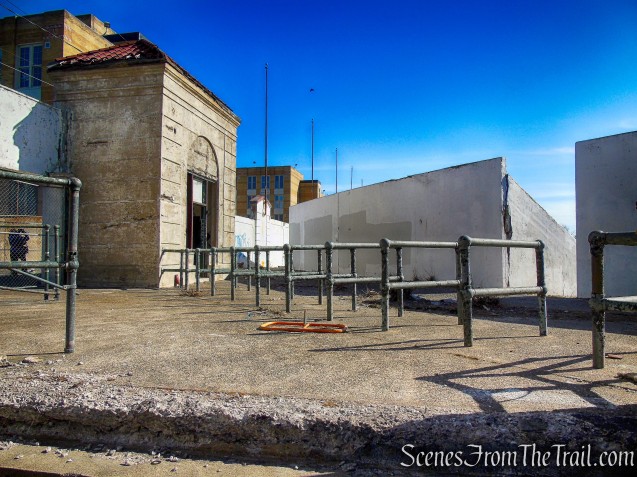April 8, 2018 – Paterson, New Jersey
Location: Maple Street, Paterson, NJ 07501
Hinchliffe Stadium, which was dedicated in 1932 and structurally completed in 1934, served as the home field for the New York Black Yankees between 1933 and 1937, and then again from 1939 to 1945. Hinchliffe is possibly the sole surviving regular home field for a Negro League baseball team in the Mid-Atlantic region.

Hinchliffe Stadium
The stadium was named after former Paterson City Mayor, John V. Hinchliffe, who served during planning and construction of the stadium between 1929 and 1932. The stadium was designated a National Historic Landmark in March 2013 and a Paterson Historic Landmark in May 2013. In December 2014 legislation was passed in the United States Congress to include the stadium in the Paterson Great Falls National Historical Park.

Hinchliffe Stadium
The stadium is situated on a bluff overlooking the Great Falls and in close proximity to Manhattan. Hinchliffe’s great location only added beauty to its magnetic pull in the 1930’s for a huge population of working-class fans, hungry for sports. It became the perfect venue for baseball invitationals and barnstorming games.

Hinchliffe Stadium
The cast-concrete, 10,000-seat Art Deco style stadium contains an athletic field and a running track. Hinchliffe has been used for sporting events such as exhibition, regular season, and champion baseball, football, boxing, track and field events and automotive and motorcycle racing. During the 1940’s, the Andrews Sisters and Abbott and Costello performed at Hinchliffe Stadium. Duke Ellington performed one of his last concerts here in 1971.

Hinchliffe Stadium
In September 1933 during their first Hinchliffe season, the New York Black Yankees played the Philadelphia Stars in the Colored Championship of the Nation. They lost the championship, but not their momentum. They opened the following season with an eight-game winning streak. The streak ending ninth game with the Pittsburgh Crawfords, came on July 28, 1934. A face-off that saw Hall of Famers Josh Gibson, Judy Johnson, James “Cool Papa” Bell, and Oscar Charleston all play in the regular season battle.

Hinchliffe Stadium
Paterson native and Hall-of-Fame baseball player Larry Doby was playing at Hinchliffe Stadium with the local high school team in 1942 when he was scouted for the Negro National League’s Newark Eagles. Later, when signed by the Cleveland Indians in 1947, Doby became the second black baseball player to break the major league color barrier, and first black player in the American League.

Hinchliffe Stadium
Doby, an all-around athlete at Eastside High School, had led his teammates to the Paterson baseball title in ’41 and ’42, all at Hinchliffe Stadium. And it was here in 1942 that he and his lifelong friend Monte Irvin, were scouted for the Newark Eagles, in what he himself recounted at his Hall-of-Fame induction in 1998, as one of the most memorable moments of his life.

Hinchliffe Stadium
The New York Cubans called Hinchliffe Stadium home in their second season in the Negro National League (1936). The team featured Cubans star Martin Dihigo (HOF 1977), a resourceful ballplayer who played all nine positions at various points in his career. He began as a second baseman, but found his true talents on the pitching mound. Paterson rooters came out on June 6, 1936 to marvel at his prowess as the Cubans faced their league rivals, the Newark Eagles, with two future Hall of Famers in the lineup: third baseman Ray Dandridge (HOF 1987) and shortstop Willie Wells (HOF 1997). The right-handed Dihigo struck out six Newark batters in the course of the game, and then proved he was a threat with the bat too by hitting a solo home run en route to a 12-5 victory for the Cubans.

Hinchliffe Stadium
Hinchliffe began a slow decline in the late ‘fifties, and was sold in 1963 for a single dollar to the Paterson Public Schools, which had managed it since 1932. After two overhauls (the first in ’63-’64 to enlarge the running track and outfield, the second in 1983 to put in itchy fiberglass seating and lay Astroturf) and many years of scrappy maintenance, it was officially closed in 1997.

Hinchliffe Stadium
Since then the city and the stadium’s friends have been working on a plan to bring back the stadium to its former glory. Work officially began in September 2017 on Phase 1 of the Hinchliffe Stadium Rehabilitation project.

Hinchliffe Stadium
The first phase will rehabilitate the stadium’s facade along Liberty Street, restore four ticket booths and replace decorative features such as the old terracotta tiles and metal gates.

Hinchliffe Stadium
Once home to the NY Black Yankees and the NY Cubans of the Negro League, this once proud stadium sits in ruins in the middle of a city block.

Hinchliffe Stadium
On the stadium’s 70th anniversary in 2002, the “Friends of Hinchliffe Stadium” was formed to advocate for the redevelopment of the stadium, as the owner, Paterson Public Schools, was threatening its demolition. The Friends group, partially funded by the Paterson Historic Preservation Commission, was instrumental in listing the stadium in the National Register.

Hinchliffe Stadium
Hinchliffe Stadium is one of three Negro League ball parks still in existence. It has been designated as a national historic landmark, the only baseball stadium in the country with such a designation.

Hinchliffe Stadium
Although this stadium will probably never be restored to its former glory, one can only hope that it will be preserved. It is so rich in history, not just in sports, but in American history as well. I had never heard of Hinchliffe Stadium until doing research for a hike in the area. I am glad that I got a chance to learn of its history and also pay it a visit. Now PLAY BALL!
Sources:
Thank you for the great informative article on this site, and for the photos that allowed me to picture it as it was in its heyday.
LikeLiked by 1 person